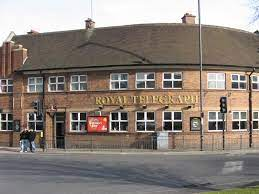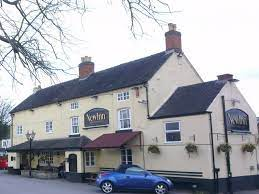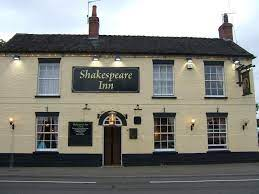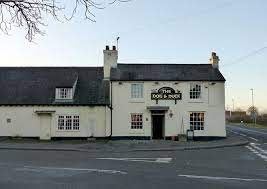It was mid-afternoon when I arrived and the weather was unsettled but I wasn't about to let Spring showers upset my day. Conveniently, my first location on this week's itinerary, was directly opposite the main exit from the station. Located in a grand Victorian building, which is part of Railway Terrace, is the Waterfall.
This massive building benefits significantly from an open plan layout, with a central horseshoe-shaped bar and a number of seating areas throughout the room. A door to the rear leads to an American-style pool lounge and there is a large function room that is regularly used for wedding receptions and the like. The interior is a mix of the original features and modern additions, giving it an impressive and imposing feel. The bar includes 4 handpulls, half of which are in use during my visit, both featuring Doom Bar. I broke with tradition slightly here when I noticed that the bar also included a range of bottled beers namely: Jennings Cumberland, Shepherd Neame Spitfire, Shepherd Neame Master Brew, Wychwood Hobgoblin and 3 from the range produced by the Guinness Brewers Project, specifically Guinness Pale Ale, Dublin Porter and West Indies Porter. I wouldn't normally buy bottled ale from a pub but I'm a firm believer in giving it a go so I opted for a bottle of Spitfire. I moved over to a small, raised area with some leather bucket chairs and took a seat, occasionally glancing at the televised coverage of the epic clash between Burton and Oldham. The Spitfire was as good as I'd come to expect from the bottled version so I was relatively pleased with my decision.
The handy thing about the route I had planned for the day was the close proximity between the different venues that I'd earmarked for a visit. My next such stop was just around the corner and I was very excited to experience it as I'd heard many excellent things and I knew that I was unlikely to be disappointed. Renowned locally and recently named CAMRA Derby Pub of the Year for 2016, is the Brunswick Inn.
Situated at the apex of what is known as the 'railway triangle', the Brunswick Inn was built in 1841 by the North Midland Railway Company, along with 80 cottages and a local store. Designed by Francis Thompson, it the form of a 4 storey triangular building with 2 of the floors being underground. Georgian in its design, it is one of, if not the earliest example of a purpose built commercial inn in the country. The area was designed as a self-contained community and the Inn traded continually as well as a public house, as well as offering accommodation, until April 1974. It was shut and left to fall into disrepair and, along with the cottages, was marked for demolition. Yet public outcry at the planned demolition forced the council to reconsider and, after protracted negotiations, the Derby Historic Buildings Trust convinced the local council to sell the buildings to the Trust for renovation. The shell renovations were completed in 1982, where upon the Historic Building Trust ran out of funding and the work on the interior could not be completed. The building again hung in the balance, until in 1987 local businessmen saw the potential for The Brunswick and purchased it from the Trust. Work on the building began straight away and, on the 3rd October 1987, The Brunswick reopened as a public house and has remained so ever since. The Inn and the cottages are now protected under Grade II listed status. In 2001, the Inn was purchased by Everards Brewery, who still own it, and is currently leased to Alan Pickersgill and Phillippe Larroche, both of whom are award winning licensees.
Early in 1990 construction was started on an extension to give the Brunswick Inn back its original capacity to produce its own beer.
A traditional tower style brewery built over three levels, great care was taken to keep the brewery in keeping with the history of the Inn, with lines of windows and stonework following through into the extension.
The plant itself was installed in April 1991, and on the 11th June 1991 production of Brunswick Brewing Company beer began. The brewery has a brew length of 10 imperial barrels (16.36Hl), and a maximum production of approximately 1000 imperial barrels per year.
The brewery produces beer not only for The Brunswick Inn, but also for Everards, as well as the local free trade and beer festivals. Over the years the Brunswick Brewing Company has established itself up and down the country, and has collected many awards for its ale, from local festival awards to national recognition.
The brewery is currently under the stewardship of long-time head brewer James Salmon, who along with the pubs tenants, are working to maintain the Brunswick Inn and Brewing Company as one of the premier brew pubs in the country.
The outward charm of the pub is maintained inside with lots period features, photos of the local area and lots of old brewery and beer memorabilia. The bar is relatively small and tucked into a corner of a small lounge, divided from the dining area by a number of glass and wood partition walls. The pub is brimming with a wonderful, chilled atmosphere. The bar has a massive 16 handpulls, 15 of which are in use whilst I'm there. There is certainly a lot of choice from amongst the following: Winning Post Twyford Sleeper, Winning Post Tully Bitter, Gold Course Hoptical Illusion, Oakham JHB, Stratford Stratford Gold, Everards Old Original, Everards Beacon, Everards Tiger and Brunswick's own Platform 2B, Rocket, Black Sabbath, Railway Porter, The Usual, White Feather and Triple Hop. I decided, after much deliberation, that I would go for a pint of Rocket (4.7%). This is a pale, IPA style beer, heavily dry hopped with a multitude of New World hops to give pleasant citrus and apricot flavours. It's a very delicious beer indeed and it's easy to see that The Brunswick's Pub of the Year title is well deserved. The beer is wonderfully kept and perfectly brewed, which is not surprising given that Brunswick is Derby's oldest surviving brewery. I could easily have stayed here all afternoon but there were more pubs to visit and more beers to drink so it was, sadly, time to move on.
A bit further down the road, and slightly round the corner, was my next destination. Opposite the railway line is Castle Rock's only pub in Derby, The Alexandra Hotel.
The Alexandra was built around 1890 and is named after the Danish princess who married the then Prince of Wales (later Edward VII) in 1863. The bar is now adorned with railway memorabilia (including an old station digital clock) and the lounge with breweriana as a reminder of the local heritage. The pub was the birthplace of Derby CAMRA in 1974 and has won awards in previous years, being crowned Pub of the Year in 2015 and runner-up in 2011. Inside, the pub has the traditional atmosphere and ambience of a Castle Rock venue with 9 handpulls, 8 of which are in use at the time that I'm there. One of these is given over to Old Rosie cider whilst the others all offer ale, specifically Mallinson's Chinook, Holden's Black Country Mild and the rest all being Castle Rock, namely Pilot's Wings, Harvest Pale, Midnight Owl, Screech Owl and Trent Vale Reserve. I opted for Pilot's Wings, a special edition brew made to commemorate the centenary of the First World War. This particular one is the 6th in the series and has been brewed in memory of Albert Ball, a Nottingham-born fighter pilot who became the first man during the Great War to be awarded 3 Distinguished Services Awards. He was awarded the Victoria Cross one month after his death at the age of 20. The beer itself is a hoppy pale ale with aromas of citrus and pine and an upfront bitterness, wrapped in an ABV of 5%. It's a very good beer and fitting tribute to a local legend.
My next stop was a little bit further away but still not too much of a walk and a stone's throw from the Derby Intu shopping centre. It was time for the almost obligatory trip to a Wetherspoons, if for no other reason than to use up some of my CAMRA vouchers. This particular one is the Babington Arms.
The site now occupied by the Babington Arms was once part of the gardens immediately behind the long-demolished Babbington House. This 17th Century mansion was once home to the Babbington family, whose coat of arms depicted two baboons on a large beer or wine cask. Inside, the layout is standard Wetherspoons with a long bar down one side of the room, a myriad of seating and toilets (as per usual) on a separate floor. My visit has handily coincided with the Wetherspoons ale festival, running until the end of the month. This means even more of a range than normal, which is always a massive plus. The Babington Arms boasts 18 handpulls, all but one of which is in use. Alongside the standard Spoons offerings of Pedigree, Abbot Ale, Ruddles and Doom Bar, is a varied choice that throws up the following: Sandford Orchards Pear Shaped, No. 18 Yard Hog Island, Small World Thunderbridge Stout, Small World Twin Falls, Small World Long Moor Pale, Devil's Backbone Bravo Four Point, Rudgate Ruby Mild, Otter Otter Fusion, Inveralmond Amber Bead, Orkney Norseman, Falstaff Bluebird, Mordue Wheat and Pheasantry Best Bitter. This was again a place where deliberation was required but I finally decided upon a pint of Norseman, a lovely summer ale, brewed with Maris Otter hops, giving a lively beer with a refreshing grapefruit and floral character. At only 4.4%, it's also very drinkable. The pub is very busy, this being a Saturday, so I end up leaning on one of the small drinking shelves situated opposite the bar. This isn't a bad thing as it means I can people watch and take in the atmosphere.
The Babington Arms is the furthest pub from my starting point so I now began my journey back in the direction of the station. The next pub on my agenda is in more or less a straight line from here, opposite the corner of the aforementioned a shopping centre. Sat astride the corner of a busy traffic junction is the Royal Telegraph.
Originally quite a small pub, it was built in the 1820s and named after a stage coach that ran from London to Manchester. The 'Royal' was soon dropped from the name and it was known as the Telegraph for many years. A road widening scheme took place in 1936 and the owners of the pub expanded the premises, buying out the neighbouring pub, the Prince of Wales, and two shops. The pub was then rebuilt with a long, curving frontage and an entrance at either end, a design that it still retains. It was reopened in 1937. Further internal alterations were carried out in the 1980s by Mansfield Breweries and it was renamed St. Trinian's but the name only lasted for 3 years. In 1986, the name was changed to Strutt's a name it retained until fairly recently when Marston's took the premises over and reverted to the original name. Internally, the long bar curves around the front of the pub and the space is broken up into smaller spaces for more intimate dining and drinking. One end is primarily for eating, with the far end given over to pool tables, fruit machines and darts. The middle section is a more traditional lounge bar style area. The bar includes 4 handpulls featuring Pedigree, Marston's Longer Days, Hobgoblin and Ringwood Boondoggle. I always feel a certain sentimentality for Ringwood beers so it was an easy choice for me when I selected Boondoggle, which was in excellent condition. I took some time, whilst I was enjoying my beer, to watch some of the England v Sri Lanka T20 cricket and simultaneously trying not to engage in conversation with the cricket fan on the neighbouring table.
I had 2 more pubs left on my route for the day and these were within easy walking distance of both the Royal Telegraph and the train station itself. Next up, was the aptly named Station Inn.
Situated on the busy Midland Road, the pub is approximately 250 metres from the train station. The large front room has a traditional bar and there is a pool room/function room to the rear. 2 of the 4 handpulls are in use, providing a choice between Draught Bass and Marston's New World. I decided to give the Bass a go and was then asked a question that I've never been asked before. I was given the option of Bass from the pump or direct from a large jug behind the bar. I realised quickly that this must be a good option as I could see no reason why they would offer it otherwise. Evidently the pub is famed for this unique serving method and, if I'm honest, the taste difference from the jug was noticeable and certainly added a rather tasty flavour to the beer. It's definitely something worth trying.
One pub left now and it was almost exactly back to where my journey had begun. Adjacent to the Waterfall is a pub that comes with an excellent reputation for live music and boasts a Cask Marque accreditation plaque outside the door. This boded well on first glance as I entered the Victoria Inn.
The Victoria Inn has a bar tucked into one corner of a lounge like layout with a couple of round tables and benches in two separate areas with a performance area and toilets to the rear. The bar holds 6 handpulls. How many of them were in use? None. Nada. Zip. Zero. I can only assume that the lines were being cleaned or that the pub doesn't serve real ale when there is music on through some misplaced assumption that rock fans don't like ale. I beg to differ! The one saving grace was that they at least sold bottles of Doom Bar and Hobgoblin. I went for the latter and sat at the bar having a bit of a sulk that the Cask Marque plaque seemed misplaced. I'm prepared to be proven wrong so another investigation at a later date may be in order. I know that I'd had bottled ale earlier in the day but this was at least in a venue that had at least one real ale on draught as advertised.
Despite my disappointment in the last venue, my day had been rather productive. Derby has once again proven that, whilst not all the venues are anything to write home about, the vast majority are maintaining some excellent standards of real ale. Derby is still very much the place to beat locally for real ale and whilst it continues to fly the flag, it will be very hard to beat. The ease with which it is to get to and the range and quantity of pubs that exist in close proximity to the train station make it a must for an afternoon trip, if just to have a wander around somewhere different. Improvement needed? Some, in this particular area of the city, but there are some absolute gems here too. Well done to the Brunswick Inn and the Alexandra Hotel for their numerous awards and the effort they continue to show. Overall, Derby is the place to get some decent ale down you!












